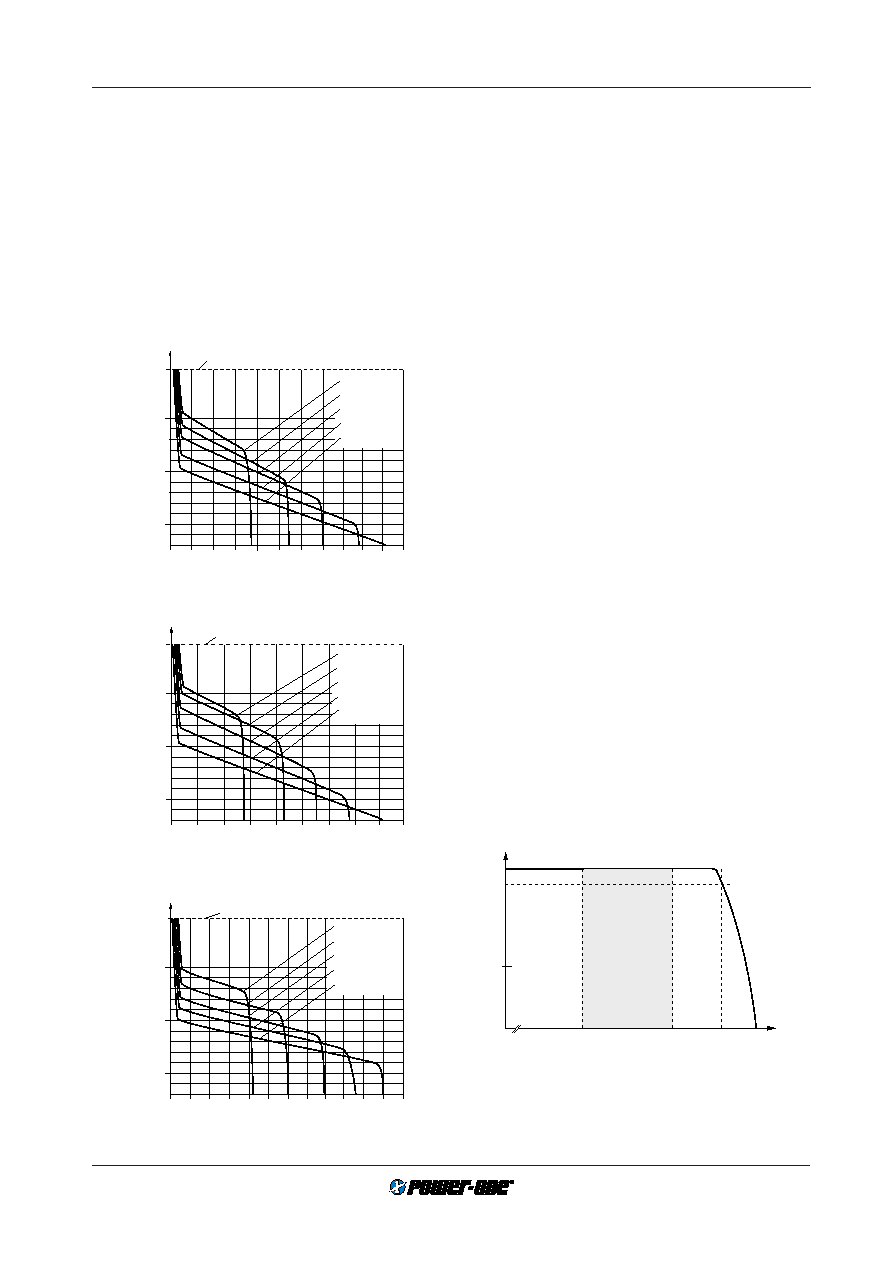- 您現(xiàn)在的位置:買賣IC網(wǎng) > PDF目錄257682 > CQ1001-7R (POWER-ONE INC) 1-OUTPUT 82 W DC-DC REG PWR SUPPLY MODULE PDF資料下載
參數(shù)資料
| 型號(hào): | CQ1001-7R |
| 廠商: | POWER-ONE INC |
| 元件分類: | 電源模塊 |
| 英文描述: | 1-OUTPUT 82 W DC-DC REG PWR SUPPLY MODULE |
| 封裝: | METAL, CASE Q01, MODULE |
| 文件頁(yè)數(shù): | 4/25頁(yè) |
| 文件大小: | 747K |
| 代理商: | CQ1001-7R |
第1頁(yè)第2頁(yè)第3頁(yè)當(dāng)前第4頁(yè)第5頁(yè)第6頁(yè)第7頁(yè)第8頁(yè)第9頁(yè)第10頁(yè)第11頁(yè)第12頁(yè)第13頁(yè)第14頁(yè)第15頁(yè)第16頁(yè)第17頁(yè)第18頁(yè)第19頁(yè)第20頁(yè)第21頁(yè)第22頁(yè)第23頁(yè)第24頁(yè)第25頁(yè)

Cassette Style
DC-DC Converters
Q Series
Edition 5/5.2000
12/25
Output Voltage Regulation of Double Output Modules
In symmetrical configuration the main output 1 is under nor-
mal conditions regulated to
Uo nom, independent of the out-
put currents. Note that if the load on output 2 is too small
(
<0.1 I
o nom), its voltage will rise, possibly activating the
overvoltage protection, which will then reduce the voltage
on both outputs.
Uo2 is dependent upon the load distribution: If each output
is loaded with at least 10% of
Io nom, the deviation of Uo2 re-
mains within
±5% of the value of U
o nom. The following fig-
ures explain the regulation with varying load distributions
up to the current limit. If
Io1 = Io2 or the two outputs are in
series-connection, the deviation of
Uo2 remains within
±1%
of the value of
Uo nom provided that the load is at least Iomin.
Uo1 + 1.0 V
Uo1
Uo1 — 1.0 V
Io2 [A]
2
34
5
Uo2 max = 28 V
0
6
Uo2 [V]
Io1 = 4.0 A
Io1 = 3.1 A
Io1 = 2.2 A
Io1 = 1.3 A
Io1 = 0.44 A
1
05113
Fig. 13
BQ...GQ 2660 output 2 voltage deviation vs. output 2 cur-
rent with different currents on output 1
Uo1 + 0.5 V
Uo1
Uo1 – 0.5 V
2
46
8
Uo2 max = 14.2 V
0
Io2 [A]
Uo2 [V]
Io1 = 7.2 A
Io1 = 5.6 A
Io1 = 4.0 A
Io1 = 2.4 A
Io1 = 0.8 A
10
05111
Fig. 11
BQ...GQ 2320 output 2 voltage deviation vs. output 2 cur-
rent with different currents on output 1
Uo1 + 0.5 V
Uo1
Uo1 – 0.5 V
2
46
8
Uo2 max = 18 V
0
Io2 [A]
Uo2 [V]
Io1 = 6.0 A
Io1 = 4.6 A
Io1 = 3.3 A
Io1 = 2.0 A
Io1 = 0.66 A
05112
Fig. 12
BQ...GQ 2540 output 2 voltage deviation vs. output 2 cur-
rent with different currents on output 1
Output Voltage Overshoot Protection
Negligible output voltage overshoot may occur if the mod-
ule is either hot plugged-in or disconnected, the input volt-
age is switched on or off, the module is switched with an in-
hibit signal, or after a reset of a short circuit and power fail-
ure.
Second Control Loop
A fully independent second control loop limits the output
voltage to approximately 1.25
U o nom (e.g. sense lines wi-
red incorrectly). It further protects the load in the unlikely
event of a malfunction of the main control circuit.
In double output modules output 1 is fully regulated with
overvoltage protection on output 2, through this second
control loop.
There is no specific built-in protection against externally
applied overvoltages.
Continuous Open-Circuit and Short-Circuit Proof
All outputs are fully protected against continuous open cir-
cuit, e.g. against no load condition (for the BQ...GQ 2000
characteristics refer to:
Output Voltage Regulation of Dou-
ble Output Modules) and all outputs are fully protected
against continuous short circuit condition by means of the
electronic current limitation on the primary side (see:
Out-
put Current Limitation).
Output current limitation
Single output units and series- or parallel-connected dou-
ble output units have a quasi rectangular constant current
limitation characteristic.
In double output units, the total current is limited, allowing
free choice of load distribution between the two outputs, up
to a total
Io1 + Io2
≤ I
o max (see: Output Voltage Regulation of
Double Output Modules). In overload (Io1 + Io2
> I
o max) both
output voltages are reduced simultaneously.
Independent outputs with symmetrical current loads both
have a rectangular current limitation characteristic.
Current distribution in overload is dependent upon the type
of overload. A short-circuit in one output will cause the full
current flow into that output whereas a resistive overload
results in more even distribution and in a reduced output
voltage.
1.0
0.95
0.5
0
Uo/Uo nom
Io
Io nom
Io max
Operation
at
reduced
temperature
only
Io L
05114
Fig. 14
Current limitation behaviour of a single or a double output
unit with series- or parallel-connected outputs
相關(guān)PDF資料 |
PDF描述 |
|---|---|
| CAT1026SE-45TE13 | 2-CHANNEL POWER SUPPLY SUPPORT CKT, PDSO8 |
| CAT1026RD2I-45 | 2-CHANNEL POWER SUPPLY SUPPORT CKT, DSO8 |
| CAT1027PE-25 | 2-CHANNEL POWER SUPPLY MANAGEMENT CKT, PDIP8 |
| CAT1027UI-30 | 2-CHANNEL POWER SUPPLY MANAGEMENT CKT, PDSO8 |
| CAT1027YI-30 | 2-CHANNEL POWER SUPPLY MANAGEMENT CKT, PDSO8 |
相關(guān)代理商/技術(shù)參數(shù) |
參數(shù)描述 |
|---|---|
| CQ1001-9R | 功能描述:EURO-CASSETTE 82W 5.1V RoHS:否 類別:電源 - 外部/內(nèi)部(非板載) >> DC DC Converters 系列:* 標(biāo)準(zhǔn)包裝:1 系列:Quint 類型:隔離 輸入電壓:24V 輸出:24V 輸出數(shù):1 輸出 - 1 @ 電流(最大):24 VDC @ 50A 輸出 - 2 @ 電流(最大):- 輸出 - 3 @ 電流(最大):- 輸出 - 4 @ 電流(最大):- 功率(瓦特):1200W 安裝類型:底座安裝 工作溫度:0°C ~ 40°C 效率:- 封裝/外殼:模塊 尺寸/尺寸:4.33" L x 9.09" W x 6.14" H(110mm x 231mm x 156mm) 包裝:散裝 電源(瓦特)- 最大:1200W 批準(zhǔn):- 其它名稱:277-69722866365-NDQUINT-BAT/24DC/12AH |
| CQ1001-9RG | 功能描述:DC/DC CONVERT 5.1V 20A 制造商:bel power solutions 系列:* 零件狀態(tài):有效 標(biāo)準(zhǔn)包裝:5 |
| CQ10663001 | 功能描述:CABLE STRANDED 制造商:te connectivity raychem cable protection 系列:* 零件狀態(tài):有效 標(biāo)準(zhǔn)包裝:1 |
| CQ10A1KB394K3 | 制造商:ARIZONA 功能描述:CAPACITOR MILITARY FILM 制造商:DEARBORN ELECTRONICS INC 功能描述:CAPACITOR MILITARY FILM |
| CQ10A1KC224K3 | 制造商: 功能描述: 制造商:undefined 功能描述: |
發(fā)布緊急采購(gòu),3分鐘左右您將得到回復(fù)。